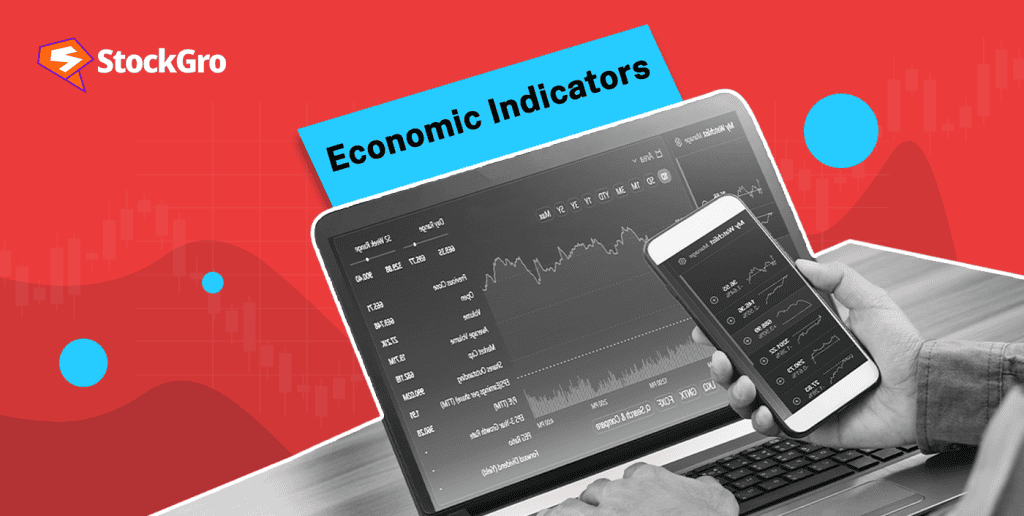
Economics is an art and science. The assumptions and forecasting in economics makes it an art. The widespread viability and applicability of economics laws make it a science. This amalgamation is the reason for its strong rationality. Usually, experts believe that economics has the answer to all the monetary questions in the world.
The four factors of production (FOPs) are land, labour, capital and entrepreneur. Their payments – Rent, wages, interest and profits; are the money supply of every economy. However, any changes in the functioning of these FOPs can alter the course of the market.
The stock market is a part of this economy, and it facilitates the transfer of capital to the business and helps businesses run the demand-supply cycle. Therefore, market dynamics play a crucial role in it. Some leading economic indicators show a significant effect on the price movement in the stock market.
Let’s analyse the effect of these indicators on the stock market.
Economic indicators in the stock market
The data set used to assess the market health is known as economic indicators. They indicate the soundness of an economy. Moreover, intricate details regarding the growth drivers or pain points of the economy are explicitly expressed by these economic indicators.
These indicators can also help in the future forecasts for the economy. There are mainly two types of economic indicators:
- Leading – These economic indicators have a strong impact on the forecasts. Usually, they are released by government authorities.
- Lagging – They have comparatively low impact and are heavily based on historical data.
Also, read Global events impacting stock markets.
Leading economic indicators
GDP growth is usually used to compare among different countries. GDP is the sum of total consumption, investments, government expenditure, and net exports (export-import). The GDP growth rate ascertained for a country forecasts confidence in the economy.
When a country has a strong GDP growth rate, confidence is reflected in the investment space. One of the main effects is observed in the confidence of foreign investors in the country’s stock market. These are directly related to each other.
For example, India has observed decent growth in the real GDP, and it is reflected in the foreign portfolio investments (FPI) and foreign institutional investments (FII). It ultimately affects the stock market. However, FIIs and FPIs, being volatile, have an ambiguous impact.
| Financial Year | GDP growth rate | FPI/FII investments | NIFTY 50 growth |
| 2021-22 | 7% | (151%) | 18.8% |
| 2022-23 | 7.8% | 73% | (0.6%) |
| 2023-24 | 6.8% | 653% | 28.6% |
- Inflation data
Inflation is generally referred to as a price rise. It has a significant impact on the stock market. When the inflation rate is high, the purchasing power is reduced. This further affects the spending and consumption of the individuals in the market.
Moreover, investors are influxing less funds in the market, which can impact liquidity. Value stocks are evaluated based on their cash flows. Therefore, these stocks may have a positive performance during such a period.
In India, inflation is indicated by the Consumer Price Index (CPI). Investors also track it to forecast price movement and suitable stock scripts. CPI excludes food and crude prices.
For example, in India, CPI has been trailing below 6% from September 2023, which indicates a positive outlook. As of September 2024, the NIFTY 50 has grown by nearly 28.5% for the same period. Moreover, in December 2023, when CPI increased to 5.93%, the stock market declined by 0.02% in the following month.
It refers to a set of decisions taken by the central bank regarding the interest rates and other regulatory features of the economy. If the interest rates are reduced, the lending from such companies may increase, directly affecting the operational performance of the company. The bond market also experiences interest rate changes.
For example, recently, when the Bank of Japan increased its interest rates by 0.25% on July 31, 2024, one of the main stock indexes of Japan – Nikkei 225 experienced a heavy decline of 2.5% the following day. Nikkei 225 is one of the most significant market indexes in the world. Therefore, following its fall, indices like the S&P 500 and NASDAQ Composite fell by 1.5% and 2.2%.
Fiscal policy refers to the Union Budget in layman’s terms. The central government lays out the estimations of spending and income. Moreover, data regarding the previous financial year is also presented. Also, announcements regarding budget allocations, taxation norms, and other government policies are made in the budget. The stock market fluctuations on the day of the budget express investor’s confidence in the country’s outlook.
For example, on July 23, 2024, the Budget 2024 was presented in India. It announced some significant changes in the tax structure for capital gains. These are gains from investments. Therefore, the stock market started fluctuating. NIFTY 50 closed down by 0.3% and Nifty Bank Index by 1.7%.
- Unemployment data
The unemployment data refers to the number of unemployed people, per person in the labour force. It indicates the efficiency of businesses in the economy in terms of job creation in the market. Unemployment leads to low income levels and impacts overall consumption and investments.
When the unemployment rate rises, the stock market anticipates burden and operational inefficiency. Therefore, the inverse effect is experienced in the market.
For example, when the July unemployment rate was announced on August 2, 2024, the rate increased to 4%. The US market (S&P 500), on the same day, was down by 1.8%.
- Crude oil prices
Crude oil is a significant raw material in many businesses. Moreover, due to its scarce availability, its prices fluctuate as per the market conditions of its demand and supply. Therefore, it is a leading economic indicator impacting the stock market.
Markets tap the demand-supply news and its sentiment heavily, as it can affect businesses significantly.
For example, when Russia invaded Ukraine in early 2022, the stock markets all over the world were nervous. The pandemic shock, along with war news. was weakening them. Russia is one of the most important crude oil suppliers in the world. Therefore, when the US sanctioned Russia (due to war), crude oil prices started shooting up, and in May 2022, it marked its almost a decade high. In the same period, indices like Dow Jones and S&P 500 experienced a significant decline.
An interesting read: Everything you need to know about Crude oil trading in India
Lagging economic indicators
- Exchange rate
The world is a connected place, and currency is appreciated or depreciated as per its requirement for trade. The US Dollar is one of the prominent global currencies. The exchange rate refers to the value of the domestic currency, per value of foreign currency. The trade conditions highly affect the exchange rate between two countries.
There are constant fluctuations in the exchange rates that lead to appreciation or depreciation of domestic currency. Stock market entities mainly operating in the export-heavy segments are affected when the currency depreciates. The Opposite stands true for importing segments.
For example, during the middle of March 2024, the Indian rupee was depreciating against the USD. The Information Technology (IT) sector, which exports its service, experienced the effect. Nifty IT was down by nearly 7% in a similar period. IT companies stocks like Infosys and TCS were down by approximately 9% and 5%, respectively.
- Inter-country economic indicators
Some conditions arising due to inter-country contracts, economic situations, etc., can impact the related stocks in the stock market. These can be bagging government contracts, plant establishments, government approvals, regulatory changes, sector-specific changes, etc.
For example, on February 16, 2024, the Defence Acquisition Council (DAC) approved a capacity appraisal proposal for the armed forces and Indian Coast Guard force. It created an opportunity for some state-owned defence stocks. Stocks like that of Hindustan Aeronautics Ltd (HAL) and MTAR Technologies Ltd surged by 1.2% and 3.1% on a similar day, respectively.
Understanding the impact of economic indicators on the stock market can benefit you!
The stock market is a maze for many. There are so many factors impacting the prices and volume in the stock market. Assessing all can be a tough task. However, economic indicators have a notable impact on the stock market as they affect the core operations of an economy or businesses. Therefore, understanding the impact of economic indicators on the stock market would help investors tap market opportunities.
Summary
Economics seems a mystery to many due to its intertwined effects on different prospects on individual, macro and even geo-political levels. The stock market is one of the entities that is impacted heavily by different leading and lagging economic indicators. Assessing the impact of economic indicators can help investors hedge their investments or tap potential market opportunities well in time. However, one can consult their financial advisor for detailed analysis.
Must read: The anatomy of a stock market crash.
FAQs
Q1. How does GDP growth affect the stock market?
The GDP growth forecasts or rates of a country indicate the overall soundness of its economy. When GDP growth is positive and consistent, there is confidence in that country’s growth prospects. Therefore, during this time, investments may increase, businesses perform positively, etc. It leads to positive growth in the stock market.
Q2. Does interest rate hike affect the stock market?
Interest rate hikes by the central bank reduce the purchasing power. It leads to a reduction in consumption, spending and investments in the country. The stock market investments are staggered during such periods, reducing liquidity, which may also lead to bearish sentiments in the market. However, interest rates are crucial to regular money supply.
Q3. What are the four factors of production?
Land, labour, capital and entrepreneurship are the four factors of production. Their functioning is crucial to catalyse movement in the overall economy. They are paid rent, wage, interest and profits respectively. These form the money supply in an economy. The stock market helps reach entrepreneurs with the help of excess capital.
Q4. What is the relation between the employment rate and the stock market?
The unemployment rate refers to the number of unemployed people, per person in the labour force. Therefore, when the unemployment rate is high, it indicates inefficiency in job creation, reduces income levels and impacts investments in the market. Similarly, the stock market may also experience nervousness with an increase in the unemployment rate.
Q5. What is the effect of exchange rate change on the stock market?
The exchange rate refers to the expression of domestic currency in terms of foreign currency. It usually fluctuates as per the demand-supply forces. When domestic currency depreciates compared to foreign currency, the stocks in the import segment feel pressure. In India, IT stocks experience the pain of exchange rate fluctuations.

